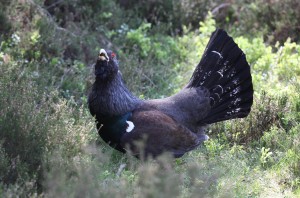 Re-introductions of some birds are well known and classic examples in the Highlands are the red kites and sea eagles. The red kite programme started in the UK with the Black Isle scheme between 1989 and 1993, with 93 young birds being brought in from Sweden. Further re-introductions were undertaken in various parts of the UK and some were very successful compared with the original Highland site. For example, there is no comparison between the numbers now being naturally fledged in the Chilterns in England compared with the Black Isle and surrounding landscape. The numbers of pairs breeding in the Chilterns are so many they cannot counted. In contrast persecution on the Black Isle has been so great that the numbers are, in comparison, very low. However, in the UK in general the scheme has been an outstanding success even bearing in mind the effort and cost involved in monitoring the birds after their release. When you think that in the 1980s only a few breeding pairs of red kites existed, in central Wales, and they could easily have died out, it puts it all into perspective.
Re-introductions of some birds are well known and classic examples in the Highlands are the red kites and sea eagles. The red kite programme started in the UK with the Black Isle scheme between 1989 and 1993, with 93 young birds being brought in from Sweden. Further re-introductions were undertaken in various parts of the UK and some were very successful compared with the original Highland site. For example, there is no comparison between the numbers now being naturally fledged in the Chilterns in England compared with the Black Isle and surrounding landscape. The numbers of pairs breeding in the Chilterns are so many they cannot counted. In contrast persecution on the Black Isle has been so great that the numbers are, in comparison, very low. However, in the UK in general the scheme has been an outstanding success even bearing in mind the effort and cost involved in monitoring the birds after their release. When you think that in the 1980s only a few breeding pairs of red kites existed, in central Wales, and they could easily have died out, it puts it all into perspective.
In contrast there are earlier re-introduction schemes that have largely been forgotten and such is the case with the capercaillie, the largest, by far, of the grouse family. Quite when the capercaillie became extinct is not known but records suggest it was in the late 18th century. Re-introductions took place in various place in the 19th and 20th centuries but there have always been problems. It seems likely that there are now far fewer than 300 males breeding and the future seems doubtful. The photograph gives an idea of the cock birds impressive size and coloration.
In contrast with these examples the osprey made its own way back as a breeding bird in the UK after being lost by 1840. They naturally colonised, starting in the 1950s at Loch Garten in the Highlands. What is relatively unknown is that a re-introduction scheme was started in Rutland Water in Leicestershire in 1996. Eventually 64 chicks were released and the first breeding started in 2001. Interestingly now up to five pairs breeding have raised a total of 87 chicks often with pairs of translocated birds and wild, unringed birds. A similar scheme has been undertaken with corncrakes that are more or less confined as a breeding bird to the Western Isles. The re-introduction took place a few years ago in the Nene Washes, near Peterborough and the signs now are that they are breeding succefullly and there is hope for the future. This is an elusive and enigmatic bird that once bred almost everywhere in the UK so what does the future hold?
Of all the re-introductions, perhaps the most renowned one has been the success story of the sea eagle, often known as the white-tailed eagle. Its demise is a story of endless persecution with, probably, the last female being shot in 1918. There were a couple of attempts to bring it back but this was not successful until the sustained re-introduction on the Isle of Rum in 1975. A total of 82 young birds were released by 1985. In those years I occasionally had responsibilities on Rum and seeing the sea eagles was always a thrill at any time. I was actually present when two of the young eagles were released for the first time and it is an experience I will never forget. The first Scottish bred birds nested in 1996 and since then other re-introductions have taken place including in Ireland.
Tags: highland wildlife
